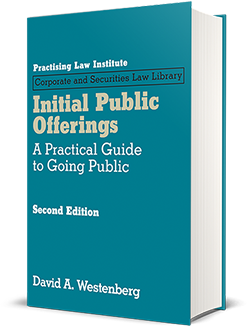
Initial Public Offerings:
A Practical Guide to Going Public
David A. Westenberg
Retired Partner
Craig Hilts
Partner
Scott Lunin
Partner
-
PART I: GETTING READY TO GO PUBLIC
-
Chapter 1
An Introduction to the IPO Market -
Chapter 2
The Elements of Success: Building a Startup Company for an Eventual IPO -
Chapter 3
Corporate Housekeeping -
Chapter 4
Accounting Preparation -
Chapter 5
Corporate Governance; and Appendices 5A-5B -
Chapter 6
Oversight, Controls, and Policies -
Chapter 7
Pre-IPO Acquisitions -
Chapter 8
Financial Planning for Executives of Pre-IPO Companies -
Chapter 9
Assembling the IPO Team
-
-
PART II: GOING PUBLIC
-
Chapter 10
An Overview of the IPO Process -
Chapter 11
The Quiet Period and Other Publicity Issues -
Chapter 12
Potential Liability and the Purposes of Due Diligence -
Chapter 13
Preparing the Form S-1 -
Chapter 14
Selling Stockholders -
Chapter 15
Stock Exchange Listing; and Appendix 15A -
Chapter 16
Initial Filing or Confidential Submission of the Form S-1 -
Chapter 17
The SEC Review Process -
Chapter 18
Marketing the Offering -
Chapter 19
Demystifying the Underwriting Process -
Chapter 20
Effectiveness, Pricing, Trading, and Closing; and Appendices 20A-20C -
Chapter 21
Out-of-the-Ordinary IPOs —Special Issues for Special Issuers
-
-
PART III: BEING PUBLIC: SELECTED POST-IPO TOPICS
-
Chapter 22
First Days as a Public Company; and Appendix 22A -
Chapter 23
Investor Relations and Other Public Communications -
Chapter 24
Post-IPO Liquidity, Fundraising, and Acquisitions
-
Reviews
If an IPO were a place, this book would be its Baedeker. Both informative and entertaining, this book draws on a wealth of personal and institutional knowledge and experience to explain and demystify the IPO process. All participants in the process—even the hardiest veterans—will find something in this book that they didn’t know before they picked it up. I know that I did.
Now more than ever, IPOs must be led by people who have an intense knowledge of the issues that arise and how a deal gets done. This superb book shares some of the most useful information on that topic that I have seen, and does so with a highly practical and readable approach that never needlessly veers into the legalistic.
An extraordinary achievement, this book is truly the roadmap to successful completion of any IPO. Now more than ever, executives, directors and advisors need comprehensive guidance to avoid the potential pitfalls of the IPO process—and to be ready for the intense scrutiny that accompanies public company life. No other IPO resource puts so much critical information together in one easy-to-use format.
There’s nothing I like more than practical guidance. And this book sure fits the bill as a detailed step-by-step guide that every practitioner should have. A perfect starter’s kit.
There is no better practical tool for anyone needing an in-depth, step-by-step guide to the IPO process. Anyone embarking on the IPO road will benefit from the book’s insights on dealing with the SEC, and from its practical advice on every business and corporate governance issue that must be addressed in taking an enterprise public.
An invaluable and comprehensive resource for the experienced practitioner and novice entrepreneur alike.
This book unravels the intricate and often perplexing mysteries of the IPO process in a cogent, straightforward fashion, and will serve as an indispensable guide for first-time or repeat IPO executives and board members. CEOs should keep this book at their side from the moment they first seriously consider an IPO… and will soon find it dog-eared with sections that inspire clarity and confidence.
This is the ultimate comprehensive and readable book covering the IPO process and corporate governance basics. Having completed two IPOs and one dual-track process that resulted in a sale of the company, I consider this a “must read” for corporate executives, board members and private equity investors contemplating an IPO or other liquidity event.
This guide takes the mystery out of the IPO process and makes it understandable to lawyer and layman alike. It should be required reading for management and boards of any company contemplating a public offering. This book sets the standard against which any future IPO guide will be measured.
A veteran of four IPOs as CFO or Audit Committee chair, I was humbled by how much I learned reading this book. Initial Public Offerings: A Practical Guide to Going Public can help save any company substantial expense, accelerate the process and lead to a more successful IPO, and is indispensable for anyone with an IPO in their future.
This book demystifies the entire IPO process, from A to Z. It is incredibly easy to find what you are looking for and, most importantly, to quickly understand the subject matter. Whether you are a C-level executive, a seasoned practitioner or Joe the Plumber, you will benefit greatly from having so much pulled together in one organized spot.
This book consolidates in one place information I had to gather from multiple sources as my last company prepared to go public. It takes the mystery out of the process, and provides real-world guidance on what you need to worry about and when. For anyone pursuing an IPO or dual-track strategy, this book is a must.
Nothing completely prepares one for the challenges of the IPO process other than having done it before. This book will serve as an excellent basic educational tool for some and a great reference book for all involved in the IPO process. I highly recommend that all C-level officers involved in an IPO keep a copy nearby.
This book is a welcome and important resource for every corporate executive and general counsel faced with the exciting and challenging prospect of an initial public offering. I wish this book had been available when our company had its IPO. I would have found this practical guide invaluable then, and I highly recommend it to anyone contemplating an IPO now.
I wish this book had been around when our company went through the IPO process. As the general counsel, I spent countless hours seeking the information that is collected in this single volume. The author lays out the nuts and bolts of the going public process, as well as real world advice not found in other guides. This is the “IPO playbook” that the general counsel of any company that intends to go public will keep on his or her desk and refer to often.
An outstanding resource for anyone involved in or preparing for an IPO.
The essential IPO guide for venture capitalists and the companies they fund. An instant classic.
This book is a comprehensive and essential resource for any company considering going public. Directors, officers and in-house counsel of emerging companies will find a wealth of practical information (from incorporation to public company) presented in an interesting and extremely readable format.
An IPO is often seen by entrepreneurs and their investors as the ultimate achievement in the development of a company. This highly readable book gives management teams a thorough, understandable overview of the complex IPO process and how to survive it.
Today’s IPO market is vastly different than that of the go-go years of the 1990s, and participants need to re-educate themselves on the new world order. This book dissects every key element of the modern IPO process and provides a framework that should be reviewed by all parties—bankers, lawyers and executive management teams.
In almost 30 years of service to publicly traded companies, as outside counsel, CLO, CFO and now as an investment banker, I have never seen a more complete, readable, well-organized and reliable guide to the IPO process. This book is the perfect blend of legal, business and real-world insight into one of the most important events in a company’s corporate life. Don’t go public without it!
An IPO is the most important event in a company’s life. This essential guide provides private companies and their boards with a powerful resource for successfully navigating the IPO process.
An IPO can be frightening, confusing and frustrating for first-timers and old-timers alike. This book pulls back the curtain and methodically dissects each aspect of the process in an easy-to-understand manner. I’ve never come across a more thorough, practical—and even engaging—IPO guide. This book is an essential resource for executives, board members, venture capitalists and others preparing to take the IPO plunge.
A thoughtful, clear and comprehensive overview of the IPO process. A must-read for company executives, securities lawyers and capital markets professionals alike.
An IPO is challenging enough, so why go in unprepared? This readable and accessible book is a prerequisite for anyone interested in going public, covering every step of the IPO process and the necessary preparations leading up to it.
Over the last 20 years, I have read most, if not all, of the books on IPOs. Without a doubt, this book is the best. It reminds me of Sunday brunch at the Rainbow Room in New York City: a fantastic smorgasbord of information—pick and choose what you want; you will not be disappointed!
An entrepreneur needs foresight, common sense and a touch of luck to build a business for an eventual IPO. I found all this and more in this book. By distilling vast experience into practical guidance, and presenting it in an engaging, easy-to-follow style, this book will enable business managers to grow their companies while avoiding the missteps that can hamstring future IPO plans.
Having spent decades as a “serial entrepreneur,” I can safely say that I have never seen a resource that is more comprehensive and insightful about the process of preparing for and completing an IPO. This information is invaluable—worth potentially thousands of times the cost of the book. Anyone involved with a company that plans to go public simply cannot afford to be without it.
IPOs have a special place in business and legal practice. This book will be a valuable and highly useful resource for all those who practice and participate in this critical process.
If you need one book on the public offering process, this is it. This masterful work explains the financial, governance and legal realities of the IPO process from a perspective valuable to entrepreneurs, first-time issuers, young attorneys and grizzled veterans alike. Chock full of pragmatic insights, the book lays bare obscure Wall Street practices and arcane SEC regulations with a clarity and precision rare in the field.
The most complete book about going public ever written—almost everything a company’s management needs to know. This book is completely up-to-date on the ever-changing requirements for going public in the U.S.
Keith F. Higgins
Partner, Ropes & Gray LLP
Stanley Keller
Partner, Edwards Angell Palmer & Dodge LLP
David M. Lynn
Partner, Morrison & Foerster LLP; former Chief Counsel, SEC Division of Corporation Finance
Brock Romanek
Editor of TheCorporateCounsel.net
Larry Sonsini
Chairman, Wilson Sonsini Goodrich & Rosati
Richard D. Truesdell, Jr.
Partner, Davis Polk and Wardwell LLP
Don Bulens
CEO of EqualLogic at the time it pursued a dual-track IPO
Royce Holland
Executive Chairman, Masergy Communications; former CEO, Allegiance Telecom and McLeodUSA
David B. Elsbree
Director, Acme Packet and Art Technology Group; retired audit partner, Deloitte & Touche
Ernest L. Godshalk
Director of GT Solar, Hittite Microwave and Verigy; retired President, COO and director of Varian Semiconductor
Greg Beecher
CFO, Teradyne; former audit partner, PricewaterhouseCoopers LLP
Rip Haak
Former CFO, EqualLogic and Enterasys Networks
Paul Milbury
Vice President of Operations and CFO, Starent Networks; former CFO, Avid Technology
Douglas C. Barnard
General Counsel, CF Industries Holdings; former partner, Kirkland & Ellis LLP
John F. Milton
Former General Counsel, EqualLogic
Patrick J. Cammarata
General Counsel, Highland Capital Partners
Jonathan A. Flint
Co-Founder and Managing General Partner, Polaris Ventures
Lisa Bonner Haines
Former General Counsel, Charles River Ventures
William S. Kaiser
Partner, Greylock Partners
M. Benjamin Howe
Co-Founder and CEO, America’s Growth Capital
Ethan E. Jacks
Managing Director, Silverwood Partners; former executive officer, Avid Technology; former partner, McDermott, Will & Emery
Kathleen Shelton Smith
Founder and Chairman, Renaissance Capital LLC
Brian Truesdale
Managing Director, Technology Investment Banking, Deutsche Bank Securities
John Tyree
Managing Director, Morgan Stanley
David G. Wyand
Shareholder, Caturano and Company, P.C.
W. Anderson Bishop
Executive Vice President, The SEC Institute
Greg Carr
Entrepreneur and Philanthropist; Co-Founder and former CEO, Boston Technology; former Chairman, Prodigy Communications
Scott Jones
Founder, Chairman and CEO, ChaCha Search
Lucian Bebchuk
Friedman Professor of Law, Economics and Finance and Director, Program on Corporate Governance, Harvard Law School
Joseph A. Grundfest
William A. Franke Professor of Law and Business and Co-Director, Rock Center on Corporate Governance, Stanford Law School; former SEC Commissioner
Jay R. Ritter
Cordell Professor of Finance, University of Florida
Authors
-

David A. Westenberg
Retired Partner
-
-

